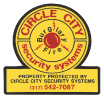 Thunder and lightning storms happen all the time. But did you know that lightning strikes and lightning fires occur most often in the summer? Know what to do to keep you and your family safe when it does strike!
Thunder and lightning storms happen all the time. But did you know that lightning strikes and lightning fires occur most often in the summer? Know what to do to keep you and your family safe when it does strike!
Outdoor Lightning Safety
- If you can hear thunder, you are within striking distance of lightning. Look for shelter inside a home, large building, or a hard-topped vehicle right away. Do not go under tall trees during a thunderstorm. Wait at least 30 minutes after the last thunder before leaving your shelter.
- Stay away from windows and doors.
- If you are in or on open water, go to land and seek shelter immediately.
- If you feel your hair stand on end, that means lightning is about to strike, squat low to the ground on the balls of your feet. Place your hands over your ears and your head between your knees. Make yourself the smallest target possible and minimize your contact with the ground. Do not lie flat on the ground. This is a last resort when a building or hard-topped vehicle is not available.
- If a person is struck by lightning, call 9-1-1 and get medical care immediately. Lightning strike victims carry no electrical charge; attend to them immediately. Check their breathing, heartbeat and pulse. CPR may be needed.
Indoor Lightning Safety
- Unplug appliances and other electrical items, like computers, and turn off air conditioners. If you are unable to unplug them turn them off.
- Stay off corded phones, computers, and other electronic equipment that put you in direct contact with electricity or plumbing.
- Avoid washing your hands, bathing, doing laundry, or washing dishes.
- If your home is struck by lightning immediately every room in your house for electrical fires. This includes your attic. Most people forget about checking their attics and don’t realize there is a fire until it’s to late. This part of your home is usually not covered with fire protection. For this reason it is very important to have it protected!
Contact Our Dedicated Team Here:
[caldera_form id=”CF591fac4fd65ed”]
Source: NFPA
